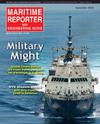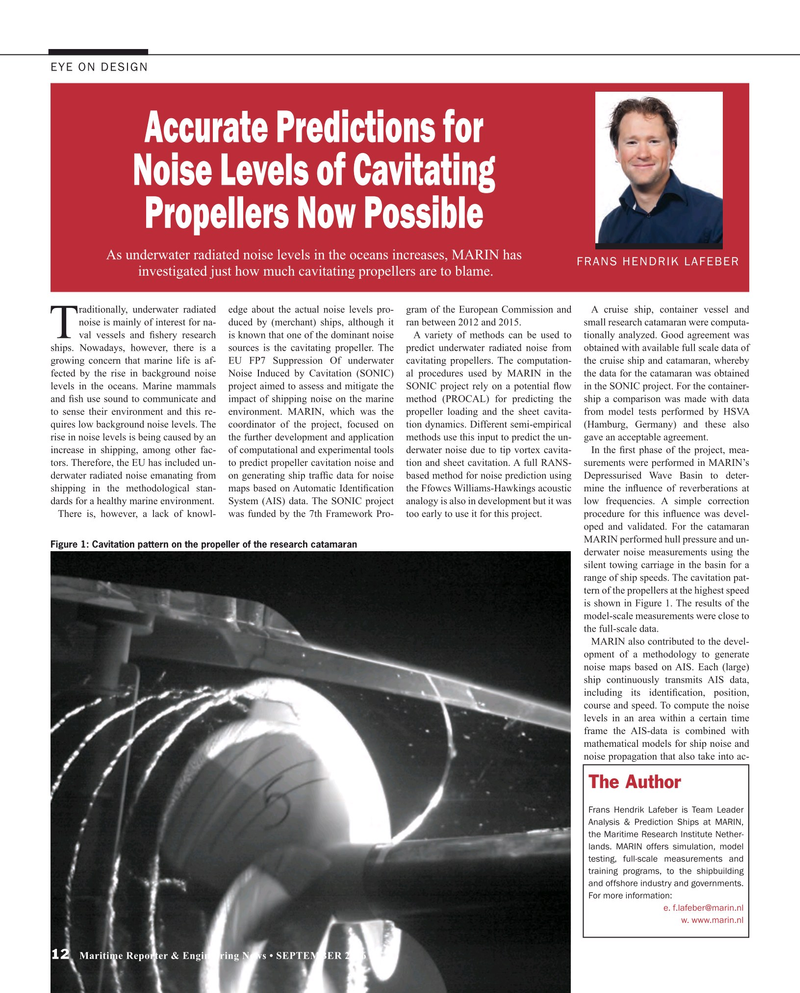
Page 12: of Maritime Reporter Magazine (September 2016)
Maritime & Ship Security
Read this page in Pdf, Flash or Html5 edition of September 2016 Maritime Reporter Magazine
EYE ON DESIGN
Accurate Predictions for
Noise Levels of Cavitating
Propellers Now Possible
As underwater radiated noise levels in the oceans increases, MARIN has
FRANS HENDRIK LAFEBER investigated just how much cavitating propellers are to blame.
raditionally, underwater radiated edge about the actual noise levels pro- gram of the European Commission and A cruise ship, container vessel and noise is mainly of interest for na- duced by (merchant) ships, although it ran between 2012 and 2015. small research catamaran were computa-
Tval vessels and ? shery research is known that one of the dominant noise A variety of methods can be used to tionally analyzed. Good agreement was ships. Nowadays, however, there is a sources is the cavitating propeller. The predict underwater radiated noise from obtained with available full scale data of growing concern that marine life is af- EU FP7 Suppression Of underwater cavitating propellers. The computation- the cruise ship and catamaran, whereby fected by the rise in background noise Noise Induced by Cavitation (SONIC) al procedures used by MARIN in the the data for the catamaran was obtained levels in the oceans. Marine mammals project aimed to assess and mitigate the SONIC project rely on a potential ? ow in the SONIC project. For the container- and ? sh use sound to communicate and impact of shipping noise on the marine method (PROCAL) for predicting the ship a comparison was made with data to sense their environment and this re- environment. MARIN, which was the propeller loading and the sheet cavita- from model tests performed by HSVA quires low background noise levels. The coordinator of the project, focused on tion dynamics. Different semi-empirical (Hamburg, Germany) and these also rise in noise levels is being caused by an the further development and application methods use this input to predict the un- gave an acceptable agreement. increase in shipping, among other fac- of computational and experimental tools derwater noise due to tip vortex cavita- In the ? rst phase of the project, mea- tors. Therefore, the EU has included un- to predict propeller cavitation noise and tion and sheet cavitation. A full RANS- surements were performed in MARIN’s derwater radiated noise emanating from on generating ship traf? c data for noise based method for noise prediction using Depressurised Wave Basin to deter- shipping in the methodological stan- maps based on Automatic Identi? cation the Ffowcs Williams-Hawkings acoustic mine the in? uence of reverberations at dards for a healthy marine environment. System (AIS) data. The SONIC project analogy is also in development but it was low frequencies. A simple correction
There is, however, a lack of knowl- was funded by the 7th Framework Pro- too early to use it for this project. procedure for this in? uence was devel- oped and validated. For the catamaran
MARIN performed hull pressure and un-
Figure 1: Cavitation pattern on the propeller of the research catamaran derwater noise measurements using the silent towing carriage in the basin for a range of ship speeds. The cavitation pat- tern of the propellers at the highest speed is shown in Figure 1. The results of the model-scale measurements were close to the full-scale data.
MARIN also contributed to the devel- opment of a methodology to generate noise maps based on AIS. Each (large) ship continuously transmits AIS data, including its identi? cation, position, course and speed. To compute the noise levels in an area within a certain time frame the AIS-data is combined with mathematical models for ship noise and noise propagation that also take into ac-
The Author
Frans Hendrik Lafeber is Team Leader
Analysis & Prediction Ships at MARIN, the Maritime Research Institute Nether- lands. MARIN offers simulation, model testing, full-scale measurements and training programs, to the shipbuilding and offshore industry and governments.
For more information: e. [email protected] w. www.marin.nl 12 Maritime Reporter & Engineering News • SEPTEMBER 2016
MR #9 (10-17).indd 12 9/2/2016 10:09:40 AM

 11
11

 13
13
